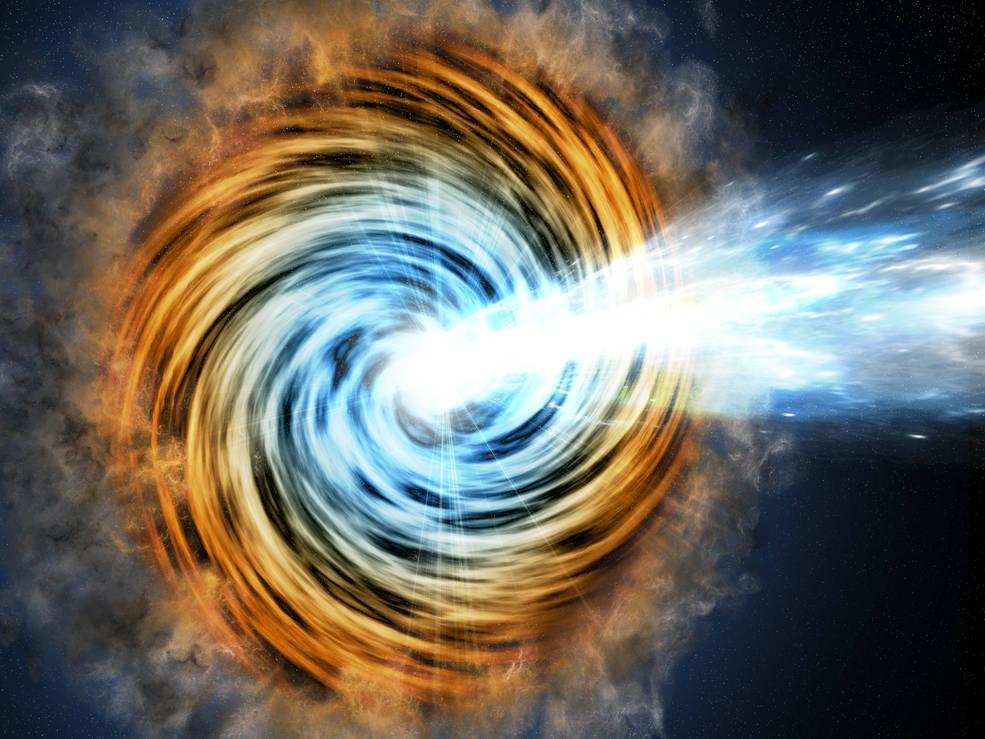A Cosmic Symphony of Light and Energy
© NASA/Goddard Space Flight Center Conceptual Image Lab
Blazars, celestial entities fueled by massive black holes, stand out as some of the most brilliant and energetic objects in the cosmos, familiar to the scientific community. Scientists have identified numerous blazars, all falling under the category of “active galactic nuclei” or AGNs, denoting their association with supermassive black holes that drive their intense luminosity.
Surrounding the black holes are rotating accretion disks comprised of various materials, including dust, gas, and stars, all being drawn towards the black hole. As a blazar’s black hole and accretion disk consume matter, the disk undergoes heating, emitting energy across the entire electromagnetic spectrum, ranging from radio waves to gamma rays. A distinctive geometric characteristic of active galactic nuclei (AGNs), including blazars, is the presence of twin relativistic jets that emanate from the poles of the swiftly rotating black hole.
Blazars display remarkable variability, frequently experiencing swift and significant changes in brightness over short durations, ranging from hours to days. In some cases, the jets associated with it demonstrate superluminal motion, a phenomenon arising from materials within the jet approaching the observer at almost the speed of light.
The blazar category encompasses three main classes: BL Lac objects, optically violently variable (OVV) quasars and Flat-Spectrum Radio Quasars. The prevailing theory suggests that BL Lac objects are inherently low-power radio galaxies, whereas OVV quasars are intrinsically potent radio-loud quasars. The term “blazar” was coined in 1978 by astronomer Edward Spiegel to describe the amalgamation of these two classes.
STRUCTURE

Blazars, akin to all active galactic nuclei (AGN), are believed to derive their energy from material spiralling into a supermassive black hole situated at the nucleus of the host galaxy. The capture of gas, dust, and occasional stars results in the formation of a heated accretion disk around the central black hole. This disk produces vast amounts of energy in the form of photons, electrons, positrons, and other elementary particles. The dimensions of this region are relatively compact, measuring approximately 10−3 parsecs in size.
SUPERMASSIVE BLACK HOLE (SMBH)
At the heart lies a supermassive black hole, an astronomical behemoth with a gravitational pull so immense that it dwarfs the mass of millions or even billions of suns. These cosmic giants, found at the core of most galaxies, including the host galaxy of a blazar, play a pivotal role in the its dynamics. The supermassive black hole acts as the central powerhouse, fueling the spectacular display of energy observed in blazars.
As matter from the surrounding environment, including gas, dust, and occasionally stars, falls into the clutches of the supermassive black hole, it forms an accretion disk—a flattened, rapidly rotating disk of material spiralling towards the black hole’s event horizon. This accretion disk becomes a primary source of energy production, releasing an intense flux of photons and high-energy particles. The gravitational forces at play lead to the creation of a hot and dynamic environment, setting the stage for the extraordinary phenomena observed in blazars.
ACCRETION DISK
The accretion disk—a swirling disk of matter that encircles the supermassive black hole at the heart of the blazar. Comprising gas, dust, and other celestial debris, this accretion disk is a key player in the transformation of gravitational potential energy into an array of radiant emissions.
As material from the disk spirals inward due to the immense gravitational forces exerted by the supermassive black hole, it undergoes intense heating and frictional forces. These processes generate a torrent of energy, manifesting in various forms, from photons to high-energy particles. The accretion disk, albeit compact, serves as a prodigious source of luminosity that characterizes the brilliance of blazars.
It is within this dynamic disk that the phenomenal energy release takes place, setting the stage for the cosmic spectacle observed across the electromagnetic spectrum.
RELATIVISTIC JET
The relativistic jet is a high-speed, collimated stream of particles emanating from the vicinity of the supermassive black hole at the blazar’s core. These jets, propelled by intense magnetic fields and energized by the gravitational forces near the black hole, play a crucial role in shaping the observable characteristics of blazars.
Travelling at velocities approaching the speed of light, these relativistic jets exhibit extraordinary phenomena such as apparent superluminal motion, an illusionary effect caused by their orientation towards the observer. The twin jets, aligned with the rotational axis of the black hole, project in opposite directions, often directly toward Earth, intensifying their visibility.
The relativistic jets are instrumental in the emission of high-energy radiation across the electromagnetic spectrum, contributing to the blazar’s luminosity. As charged particles within the jets collide and interact, they produce a cascade of radiation from radio waves to gamma rays.
VARIABILITY AND FLARES
A defining characteristic of blazar is its inherent variability, marked by rapid and dramatic fluctuations in brightness over short timescales, ranging from mere hours to days. This feature, observed across the entire electromagnetic spectrum, adds an element of unpredictability to the behaviour of blazars.
The variability is intricately linked to the processes occurring within the accretion disk and the relativistic jets. As matter interacts within these regions, dynamic changes unfold, leading to shifts in luminosity that astronomers keenly observe.
The occurrence of flares—intense, transient of variability increases in luminosity that can be observed across multiple wavelengths. Flares are indicative of rapid releases of energy within the blazar’s core regions. The mechanisms driving these flares are complex and may involve instabilities in the accretion disk or changes in the relativistic jet’s orientation.
DOPPLER BOOSTING
At the heart of a blazar’s structural brilliance lies the Doppler boosting, a key element shaping its observational characteristics. Doppler boosting is a relativistic effect arising from the high-speed motion of the relativistic jets within the blazar. These jets, propelled by the intense gravitational forces near the supermassive black hole, move at velocities close to the speed of light.
As these jets approach Earth, their motion induces a Doppler shift in the emitted radiation, enhancing the observed brightness of the blazar. This boosting effect is particularly pronounced when the jet’s motion is aligned with the observer’s line of sight, creating an illusion of increased luminosity.
Doppler boosting is crucial for the detectability of blazars across the electromagnetic spectrum. It significantly amplifies the radiation emitted by the jets, making blazars appear exceptionally bright and facilitating their identification, especially in high-energy gamma-ray observations.
KEY CHARACTERISTICS

Blazars, as a subclass of active galactic nuclei (AGN), possess several distinctive characteristics that set them apart in the cosmic panorama:
GAMMA-RAY EMISSION
The gamma-ray emission, emitting high-energy photons with extraordinary intensity. This feature distinguishes them as some of the most powerful gamma-ray sources in the universe. The gamma-ray emissions originate from the accelerated particles within the relativistic jets, moving at nearly the speed of light. Observations, often conducted by instruments like the Fermi Gamma-ray Space Telescope, provide valuable data for understanding the energetic processes near supermassive black holes in blazars.
COMPACT SIZE
Blazars are distinguished by their compact size, with the central region housing the supermassive black hole, accretion disk, and relativistic jets spanning a relatively small scale, often around 10−3 parsecs. Despite their diminutive dimensions compared to the host galaxy, blazars exhibit extraordinary luminosity and variability. This compact size amplifies the observable effects of relativistic motion and Doppler boosting, making blazars prominent sources of high-energy radiation.
HIGH LUMINOSITY
Blazars stand out in the cosmic panorama due to their exceptional luminosity, often surpassing the brightness of their host galaxies. This heightened luminosity is a consequence of the intense processes occurring near the central supermassive black hole. The accretion of matter onto the black hole, coupled with the relativistic jets emitting radiation across the electromagnetic spectrum, contributes to the blazar’s brilliance.
COSMIC PARTICLE ACCELERATORS
Blazars are recognized as natural cosmic particle accelerators, producing high-energy cosmic rays through their extraordinary processes. The relativistic jets, propelled by intense magnetic fields near the central supermassive black hole, accelerate charged particles to nearly the speed of light. These accelerated particles contribute to the dazzling emission observed across the electromagnetic spectrum, from radio waves to gamma rays.
TYPES OF BLAZARS

Blazars, a distinctive subclass of active galactic nuclei (AGN), encompass two primary types: BL Lac objects and optically violently variable (OVV) quasars. These types are differentiated by their spectral characteristics and observational behaviours.
BL LAC OBJECTS
BL Lac Objects are a unique and intriguing subclass of blazars, a category of active galactic nuclei. Characterized by featureless spectra, these celestial entities lack distinctive emission lines, making their identification challenging. BL Lac objects are renowned for their intense and rapid variability across the electromagnetic spectrum, from radio waves to gamma rays. Their intrinsic nature as low-power radio galaxies is attributed to the orientation of their relativistic jets, which point directly towards Earth.
OPTICALLY VIOLENTLY VARIABLE (OVV) QUASARS
Optically Violently Variable (OVV) Quasars are a subset of blazars, a class of active galactic nuclei. Distinguished by their strong optical variability, OVV quasars exhibit intense fluctuations in luminosity over relatively short timescales. These celestial objects are considered intrinsically powerful radio-loud quasars, showcasing relativistic jets oriented toward the observer. The term “blazar” encompasses both BL Lac objects and OVV quasars, emphasizing their shared characteristics of variability and jet alignment.
FLAT-SPECTRUM RADIO QUASARS (FSRQs)
Flat-Spectrum Radio Quasars (FSRQs) are a prominent subclass of blazars, a type of active galactic nucleus. Distinguished by their strong radio emission and distinct emission lines in their spectra, FSRQs exhibit a flat radio spectrum. These blazars often display intense and variable gamma-ray emissions, making them significant sources for studies in high-energy astrophysics. FSRQs typically have powerful relativistic jets oriented towards the observer, contributing to their high luminosity. Well-known examples include 3C 273 and PKS 1510-089.
